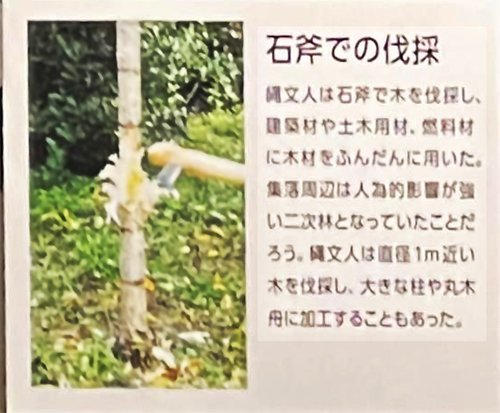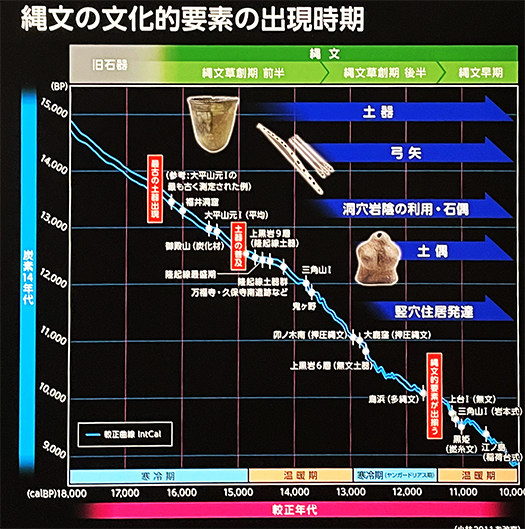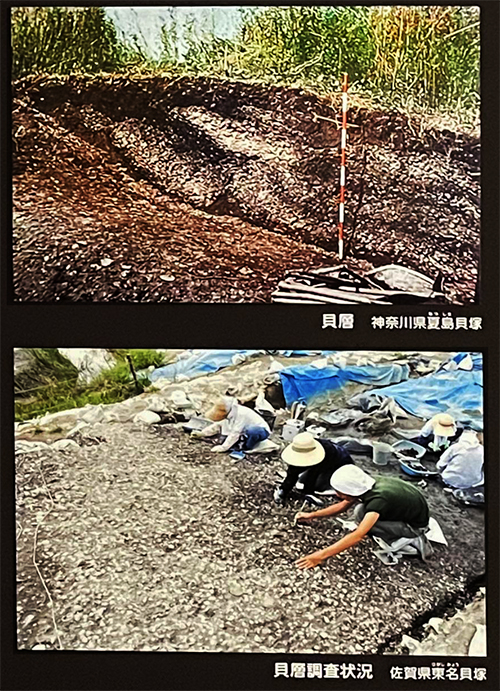


〜「定住生活のはじまり」
本格的な定住生活の開始によって人々は「移動」以外の方法で
さまざまな問題を解決する必要に迫られた。
動植物利用技術の発達や計画的な土地利用、生活規範の整備、
呪術・祭祀の発達など社会の複雑化・高度化は定住がもたらした。〜
鹿児島県上野原遺跡では9500年前くらいから大きな集落が形成されていた。
「定型化」された竪穴住居や屋外炉などが発見されている。
残念ながらこの遺跡は「鬼界カルデラ」大噴火(約7,300年前)で衰退した。
縄文の集住集落では照葉樹林から多くの「建築資材」が石斧で切り出され
社会的な建築組織・集団の存在も彷彿させるような
「規格住宅」的な痕跡が見られるというのですね。
「石斧での伐採」という説明パネルがあったけれど、
人間社会の形成は同時に「分業」的な労務分担が進んだことも自明。
前面の海から漁撈を専門として食物獲得する人々もいただろうし、
一方で住宅や土木・丸木舟制作などで「木を使って」ものづくりすることが
専門化したことも当然想像可能。
当たり前だけれど、定住と「家づくり」技術発達は一体のもの。
結果として「竪穴」という温熱環境重視型の家づくりが主流になった。
竪穴形式は自然発生的だったのは世界の遺跡でも普遍的ということからわかる。
日本列島でも東日本、北海道でも同様に作られた。
鹿児島という南国でも寒冷地・北海道でも共通だった。


集落と定住が始まることで同時に祭祀も始められる。
鹿児島では土器の坪を土中に埋める祭祀が行われ
千葉県取掛西貝塚ではイノシシやシカの頭骨を集積した祭祀が行われた。
集住してさまざまな機能分担することが進行すると同時期に
祭祀はそうした社会の結合をより強めるものとして機能したように考えられる。
日本的八百万の神という祖型を見る思いがしてくる。
ウォーターフロントと後背の照葉樹林という独立的な生活圏形成は
この八百万の神と通底する文化構造のように思われますね。
ウォーターフロントが生活圏であったことは、貝塚を必然化させる。
海産資源のうち、もっとも始原的なのは貝類であろうことは間違いない。
前浜で貝を拾えば集落成員のその日の必要採取量が獲得できたと思う。
その残骸として各地に貝塚が遺されていく。
縄文の世の社会構造が、日本という国の原型を作ったことが見えてくる。
浦島太郎の説話には、こういった背景文化圏の想定がごく自然。
こういう「海洋国家」という概念は人類的には珍しいと思える。
少なくとも東アジア圏では農耕が発展した大河川流域での中華国家など
大陸型・征服型王朝の考え方が主流だっただろうけれど、
そういう考え方からは相当に異質な思考ベースが列島社会には根付いていた。
こういう八百万の社会認識は平和国家の基盤とも思われる。
English version⬇
Jomon’s Shoreline Forest is the Mother of Wooden Construction 37,000 Year History of the Japanese Archipelago – 16
Urashima Taro is an expression of the roots of the Japanese people. The one-set settlement of the sea and mountains in the archipelago is a maritime nation type. The settlement created the division of labor and the development of wooden construction technology. The development of wood construction technology.
〜The Beginning of Settled Life
With the start of full-scale settlement, people were forced to solve various problems
The development of plant and animal utilization technology, planned land use
The development of plant and animal husbandry techniques, planned land use, the development of norms for daily life, and the development of magic and rituals all contributed to the complexity and sophistication of society.
The development of plant and animal husbandry technology, planned land use, the development of norms for daily life, and the development of magic and rituals were all brought about by settlement. ~.
At the Uenohara site in Kagoshima Prefecture, a large settlement was formed around 9,500 years ago.
A “standardized” pit dwelling and an outdoor furnace have been found at the site.
Unfortunately, this site was decimated by the great eruption of the “Kikai Caldera” (about 7,300 years ago).
In Jomon settlements, many “building materials” were quarried from the evergreen forests with stone axes.
The existence of a social architectural organization or group is also reminiscent of the Jomon settlements.
The Jomon settlements were also said to have traces of “standardized housing,” reminiscent of the existence of a social building organization or group.
There was a panel explaining the “stone axe logging.
It is obvious that the formation of human society was accompanied by a “division of labor.
There must have been people who specialized in fishing and obtaining food from the sea in front of the house, and on the other hand, there must have been people who specialized in housing, civil engineering, and logging.
On the other hand, it is also possible to imagine that people specialized in “working with wood” for housing, civil engineering, and the production of wooden boats.
It is also possible to imagine that they specialized in “working with wood” for housing, civil engineering, boat building, and so on.
It is natural, but settlement and the development of “house-building” technology are one and the same.
As a result, the “pit” style of house building, which emphasizes thermal environment, became the mainstream.
The fact that the pit style was a spontaneous development is evident from the fact that it is universal among archaeological sites around the world.
In the Japanese archipelago, they were built in eastern Japan and Hokkaido as well.
It was common both in Kagoshima, a southern country, and in Hokkaido, a cold region.
With the beginning of settlements and settlement, rituals were initiated at the same time.
In Kagoshima, rituals were held to bury tsubos of earthenware in the ground.
At Torikake-nishi Shell Mound in Chiba Prefecture, rituals were held to collect the skulls of wild boars and deer.
At the same time that various functions were being shared among people living in clusters, rituals were also being performed to promote social cohesion and to promote the sharing of various functions.
Rituals seem to have functioned as a way to strengthen such social bonds.
This is the ancestral form of the Japanese “8,000,000 gods.
The formation of independent spheres of life along the waterfront and in the shiny-leaved forests in the hinterland
The independent living area formation of the waterfront and the terrestrial forests in the background seems to be a cultural structure that is commonly associated with the eight million deities.
The fact that the waterfront was a living area makes shell mounds inevitable.
Of all the marine resources, shellfish are undoubtedly the most primitive.
I think that picking up shellfish on the foreshore would have provided the community members with the necessary amount for that day’s gathering.
Shell middens were left behind as remnants of these shell middens in various locations.
The social structure of the Jomon period is the prototype for the nation of Japan.
In the legend of Urashima Taro, the assumption of such a background cultural sphere is quite natural.
This kind of concept of a “maritime nation” seems to be rare in human terms.
At least in the East Asian sphere, such as the Chinese nation in a large river basin where agriculture developed.
In East Asia at least, the idea of continental and conquering dynasties, such as the Chinese state in a large river basin where agriculture was developed, would have been the mainstream.
However, the archipelago society was rooted in a thought base that was quite different from such a way of thinking.
This kind of social recognition of the eight million people is thought to be the foundation of a peaceful nation.
Posted on 11月 16th, 2022 by 三木 奎吾
Filed under: 住宅マーケティング, 歴史探訪







コメントを投稿
「※誹謗中傷や、悪意のある書き込み、営利目的などのコメントを防ぐために、投稿された全てのコメントは一時的に保留されますのでご了承ください。」
You must be logged in to post a comment.